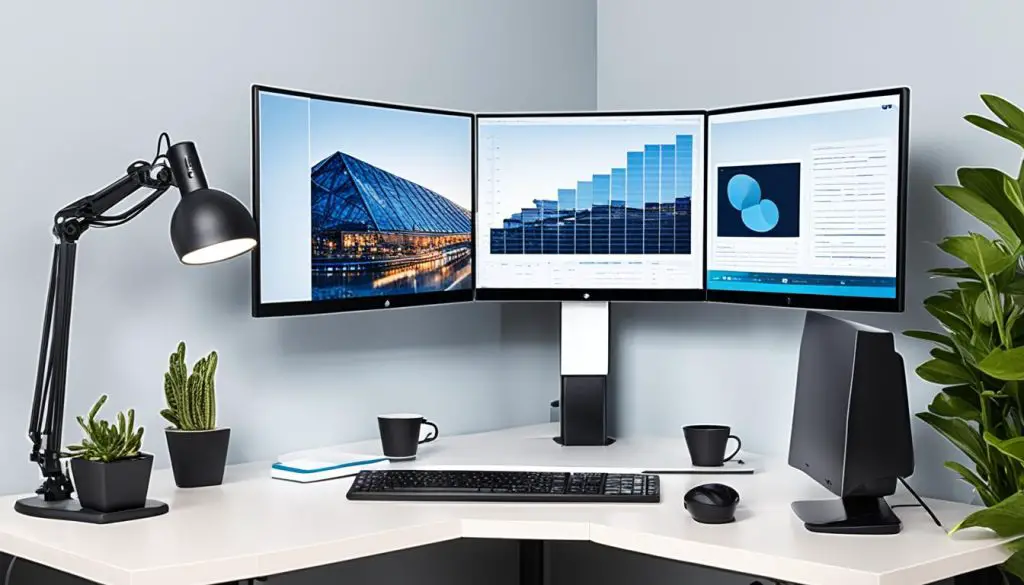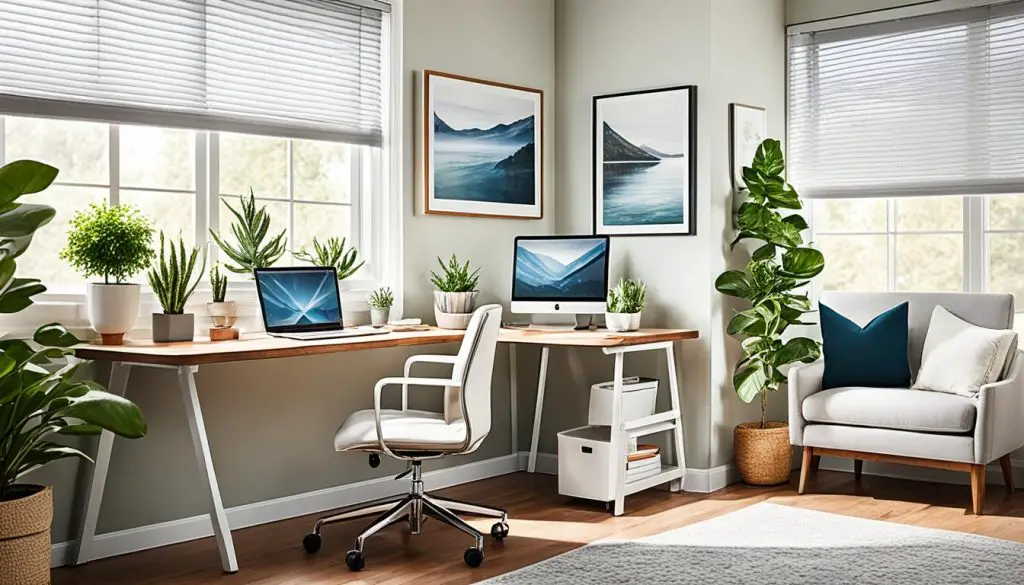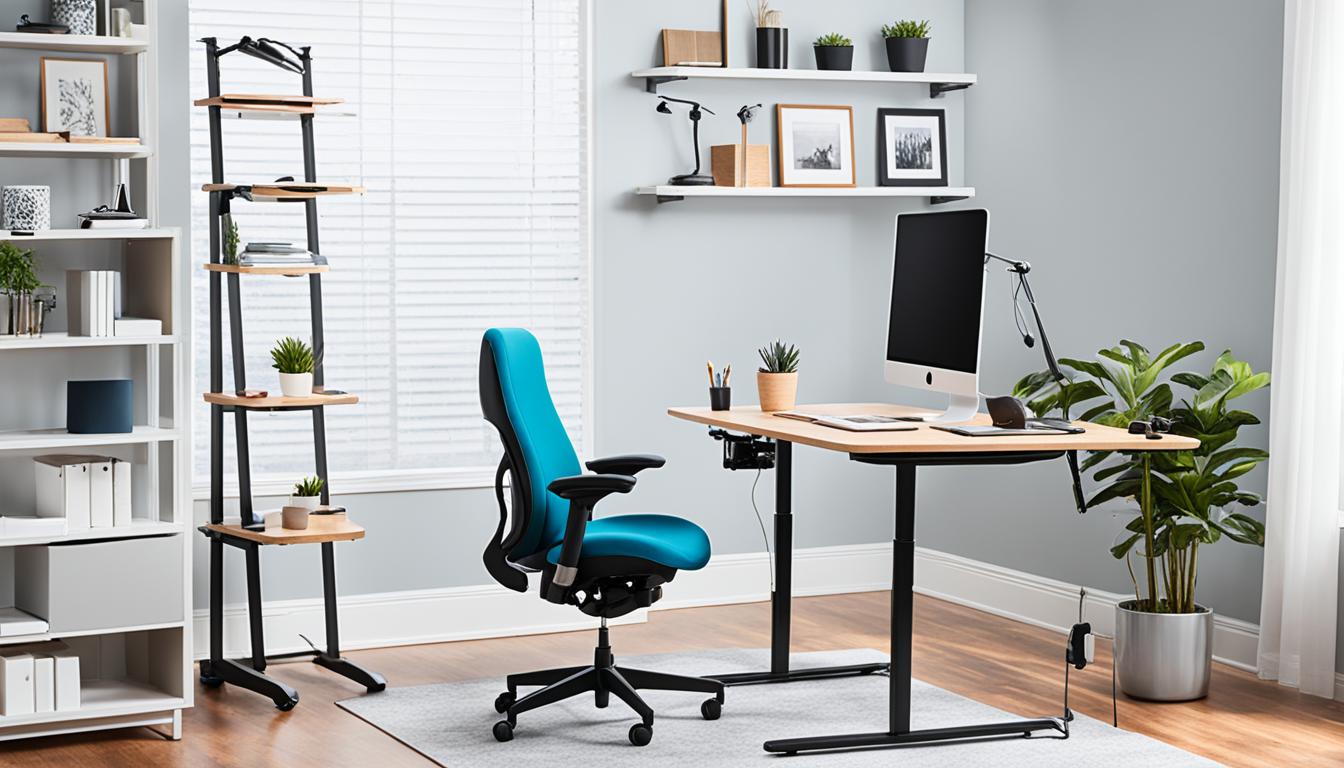Do you find it hard to work from home because of pain and discomfort? I know this feeling well, having seen my wife deal with endometriosis and fibromyalgia. A comfy and well-designed home office can really make a difference. It could increase how much work you get done and help you feel better overall. Six in 10 American adults live with a chronic disease,1 which shows the need for workspaces that suit their health needs.
Chronic illness lasts for 3 months or longer and can’t be stopped by vaccines or healed by medicine.1 It makes people manage medical needs, live with health limits, and handle the worries their condition brings.1 I’ve seen how hard it is to keep going like everything is normal when you’re not well. This is why we’re talking about setting up a cozy and smart home office. It’s all about making pain less, helping you focus, and meeting the special needs of people with chronic sickness.
The Importance of an Ergonomic Workspace
Office ergonomics is about setting up your space to work comfortably all day. If you sit at a desk for work, you know it can sometimes be painful. But, with the right setup, you can avoid problems like neck and back pain or sore wrists.2 Sitting too much and doing the same movements over and over can cause pain and health issues over time.2 Poor office ergonomics can lead to discomfort, especially in your back, neck, and wrists.2 Following ergonomic guidelines in your workspace can lower the chances of getting hurt.
Reducing Physical Strain and Discomfort
How high your chair is, how far your computer is, and how you hold your body all matter.3 Your computer screen should be at eye level or right below it.3 It needs to be 20 to 40 inches away as well.3 For laptop users, an external keyboard and mouse could make your setup better.3 Keep tools you use a lot close to avoid stretching too much.3 If you’re on the phone a lot, use a headset to keep your hands and neck free. Good ergonomics reduces how hard your body works and feels at your desk.
Improving Productivity and Focus
2 A workspace that’s ergonomically correct can make you work better and stay focused.2 Don’t forget to take short breaks to stretch every hour, which can make you feel better and work more effectively.2 Good lighting is also important; it can keep your eyes from getting tired.2 Investing in an ergonomic setup is like investing in your health. It can stop problems from sitting wrong or sitting too long.
Choosing the Right Office Chair
Setting up a workspace? Picking the right chair is key. Look for one that’s comfy, supportive, and can be adjusted. It’s best if the chair helps you sit straight and has armrests. These armrests should keep your arms and elbows in a good position.3
Proper Lumbar Support
Don’t go for chairs that are too soft. They make you sink in, affecting your back and neck. Make sure the chair supports the curve of your back well.3
Adjustable Height and Armrests
It’s important that the chair is adjustable in height. This helps you keep your feet flat on the floor, with thighs level. Also, adjustable armrests can make your workday easier, supporting your upper body.3
Desk Setup for Optimal Positioning
Creating the right desk setup is key for good posture and comfort all day. It’s important to have your computer screen at eye level. This way, you won’t hunch over too much.3 Put the monitor an arm’s length away, between 20 and 40 inches, for best results.3
Desk Height and Leg Space
Make sure your desk has enough room for your legs and feet. Don’t put stuff under it; this takes up space and makes it hard to sit right. Keeping the area under the desk clear is an ergonomic tip for a comfy posture and to prevent body strain.
Keyboard and Mouse Placement
If you use a laptop, get a stand to lift it up and better the view.3 Also, using an external keyboard and mouse at the correct height and distance is smart.3 It mimics a desktop setup, keeping your wrists, arms, and shoulders in the right position. OSHA gives detailed advice on how to set up your workstation well. It covers keyboards, mice, and more, to prevent body aches.3
Think about how your desk, screen, and devices are placed. Doing this wisely can make a cozy and efficient home office. It reduces stress on your body and helps you stay healthy.3
Monitor Placement and Lighting
Setting up your monitor correctly is key to easing eye and neck issues4. It should be right in front of you, in line with your keyboard, at arm’s length.4 Keep it between 20 to 40 inches from your eyes4. The top of the screen should meet, or be just below, your eyes4. Lower the monitor by 1 to 2 inches if you wear bifocals for better view4.
Reducing Eye Strain and Neck Pain
Place your monitor well and use good lighting to cut down on eye and neck aches4. Adjustable monitor arms help a lot. They put your screen at the right level, so you don’t have to bend your neck4. These adjustable arms are essential. They let you see different types of content on your screen clearly4. Today, monitor arms can move in many ways. They can swivel, tilt, and turn, making your work area more comfortable and healthier4.

Comfortable Home Office Setup Chronic Illness
Creating a home office for someone with a chronic illness needs special thought.1 About 6 out of 10 adults in America face a chronic disease.1 This means their health issue lasts over 3 months.
They might need special tech and equipment to work comfortably.
Accommodating Specific Needs
People with movement challenges could use a desk that moves up and down or a chair designed for comfort.1 Take Samantha, for instance. She adjusted her office to suit her energy levels as she deals with Crohn’s disease.1 Others might use tools that turn voice into written words, changeable lights, or special headphones if they’re bothered by noise.
The aim is to make working less tiring and more suitable for their health.
Assistive Technology and Tools
Samantha orders things like razors and warm pads to her door, reducing the energy she uses.1 She also depends on a robot vacuum to help with home chores.
The pandemic pushed many, sick or not, to make their living places better.1 Therapist Colleen Koncilja underlines how critical a comfy and helpful home is for those with a chronic health concern.1 It’s about feeling safe and in good hands. Samantha finds joy in simple pleasures like lighting candles or her hobbies – writing, cooking, and reading tarot.
Creating a Relaxing Environment
It’s vital to make a comfortable workspace at home, especially for those with chronic illnesses. The setting greatly affects your health and mood. Make sure you look at things like lighting, temperature, and clutter to lower stress.5
Lighting and Temperature Control
Good, adjustable lighting is a must. Don’t use bright lights that hurt your eyes and head. Choose softer lights that you can change by time or what you like. If your room gets too hot or cold, get a fan or heater.5
Minimizing Distractions and Clutter
Work better by keeping your space tidy and neat. Clear off your desk and areas to reduce distractions. You’ll have more freedom and focus with less mess.5
With the right lighting, temperature, and tidiness, you can cut down on stress. This will help you feel better and work more while facing a chronic illness at home.5
Incorporating Movement and Breaks
Make sure to stand up and take breaks often.6 Every hour, stretch, walk, or do quick yoga.6 Set reminders on your phone to help you remember.6 People who work at desks all day need to move more.6
Desk Stretches and Exercises
Try desk stretches and standing up to work sometimes.7 It stops you from getting hurt by doing the same things over and over.7 Stretching and moving also fights against your body getting too stiff and sore.7
Standing Workstations and Walking Breaks
Switching to a standing desk or going for walks can help if you’re often ill.6 Sitting too much can lead to serious health issues.7 Moving during the day keeps sickness and pain away.7
Pain Management Strategies
Creating an ergonomic workspace is key, but it’s not the only step. Adding ergonomic tools like a standing desk or lumbar support cushion is helpful. You can reduce discomfort this way.8 Also, relaxation techniques are effective. Trying deep breathing, meditation, or using a foam roller can help manage pain better. But always work with a healthcare professional. They can create a plan that fits your needs.
Ergonomic Accessories and Tools
Ergonomic tools are great for lessening pain at work.8 For example, standing desks let you change positions, easing the harm from sitting too long.8 Lumbar cushions and wrist rests target specific pains, such as lower back or wrist ache.
Relaxation Techniques
Adding relaxation to your day can work wonders for constant pain.8 Simple activities like deep breathing, meditation, and using a foam roller can cut stress and strain. They can make your work area more supportive, helping deal with chronic conditions.
Maintaining Work-Life Balance
Working from home with a [Comfortable Home Office Setup Chronic Illness] means keeping a good work-life balance is key. It’s important to set clear boundaries and schedules. This stops work from taking over your personal time. Think about flexible schedules. They let you take breaks, work in short times, or change your hours to suit your health needs.9 Setting boundaries and finding balance helps reduce stress and manage your condition better.
Flexible Schedules and Boundaries
For people with a [Chronic Illness], flexible schedules are very helpful. They let you adjust your workday as necessary.9 This might mean taking breaks or working in focused time blocks. It’s also important to clearly separate work from personal time. This avoids burnout and gives time to recharge.
Keeping a good work-life balance is vital for managing your [Chronic Illness]. This keeps you healthy in body and mind. By using flexible schedules and setting clear boundaries, you can make your work setup work for you. It helps you do well in your job and enjoy your life outside of work.
Energy Conservation and Pacing
Working from home with a chronic illness means saving energy and setting a good pace. I know the value of picking what’s most important, getting help when I can, and taking breaks. These help me avoid getting too tired and handle fatigue well over time.10 It’s key to spot signs of being overly tired and then adjusting my work and rest balance. This way, I keep working well.
Strategies like grouping similar tasks, having short rests, and self-care are my allies. They let me save energy and keep my focus sharp all day long.10 Watching my energy and pacing eases my chronic fatigue. It helps me work from home comfortably.
Managing Fatigue and Chronic Fatigue
Tackling chronic fatigue while working with a constant health issue is no small feat. It’s vital to see when you’re getting tired and change things so you don’t push too hard.10 This might mean tackling big tasks in smaller parts, getting help, and fitting in breaks to recharge.
Being smart about saving energy and keeping a good pace is essential for a balanced life with a chronic sickness.10 Making self-care a top priority helps me keep going. It also ensures I focus on my health besides my job.

Telecommuting and Remote Work Options
For those with chronic illness, telecommuting and remote work are big plusses. They offer flexibility and cut out the commute,11 letting you set up a workspace that meets your needs. But, working from home might lead to being too alone, getting off track, and finding it hard to separate work from your private life.
Pros and Cons of Working from Home
Thinking about the good and bad of working remotely is key to finding the best setup for you. A study found that for people with long-term health issues, the freedom and not commuting can be saving graces. Yet, the lack of regular contact and the temptation of home distractions can be real issues.
When deciding on telecommuting, think about what you really need and want, as well as what your job demands. Balancing these factors is crucial. This way, you can get the most out of working remotely without the negative effects, creating a setup that’s good for both your health and your job.11
Productivity Tools and Apps
To boost how much I get done at home, I use various tools and apps. These can be for managing time, tracking tasks, and tools for working together and talking online while not in the same office. By using these, I get better at picking what to do first, avoid getting sidetracked, and keep in touch with my team, no matter where we are. For those of us dealing with ongoing health issues, these tools are even more vital. They help us handle our work and keep our focus.
Time Management and Task Tracking
Keeping our time well and knowing what tasks to do is key for working well at home. Tools like Everhour help me a lot. It lets me track my time so I can see where it goes, mark deadlines, and make sure my day is as productive as it can be.12 With a clear picture of what I need to do and how I’m doing, I can avoid getting too tired from work and keep a good balance between work and life.
Collaboration and Communication Tools
It’s so important to stay in touch with our work buddies, even when we are far apart. For this, I use apps like Asana, Trello, and Jira, which also work well with Everhour. They make it easy to work together and talk about projects, even if we’re not all in the same place.12 Having the right set of tools makes sure I stay on track, involved, and organized, even when my health isn’t at its best.
Seeking Professional Support
Creating an ergonomic home office and using strategies help a lot. But, it’s key to work with a qualified healthcare pro for pain management.9 I’m someone dealing with a chronic illness. I’ve seen how crucial it is to get expert advice. It helps me manage my symptoms and be well.
A healthcare provider like a physical or occupational therapist gives tips. They help find the right tools and treatments for me.13 They guide me on working smart, considering my health limits and the challenges I face every day.
Getting support from pros has made my home office and work better for dealing with pain and tiredness.13 Their know-how has let me handle issues like long commutes and stress from workspaces. It’s increased how much I can get done.9 Working with a healthcare team keeps my workspace in top shape. It lets me do well in my job while caring for my health.
Source Links
- https://www.apartmenttherapy.com/how-chronically-ill-people-make-home-comfortable-36950267
- https://www.camaratachiropractic.com/blog/is-your-home-office-hurting-your-health-the-importance-of-desk-ergonomics-for-remote-workers
- https://www.mayoclinic.org/healthy-lifestyle/adult-health/in-depth/office-ergonomics/art-20046169
- https://www.zgomonitorarms.com/blognews/how-to-create-an-ergonomic-desk-layout
- https://liveinplacedesigns.com/how-home-design-can-help-you-live-with-a-chronic-illness-or-condition/
- https://spinehealth.org/article/spine-posture-workplace-ergonomics/
- https://health.clevelandclinic.org/heres-how-to-set-up-your-office-to-avoid-aches-pain
- https://worksafept.com/managing-chronic-pain-while-working-a-desk-job/
- https://www.businessnewsdaily.com/10041-manage-chronic-illness-at-work.html
- https://www.lifeofpippa.co.uk/2021/03/29/working-with-me-cfs-examples-of-workplace-adjustments/
- https://www.linkedin.com/pulse/remote-work-lifesaver-those-chronic-conditions-hennigan-she-her-
- https://everhour.com/blog/desk-setup/
- https://www.themuse.com/advice/working-living-with-a-chronic-illness
